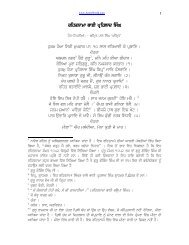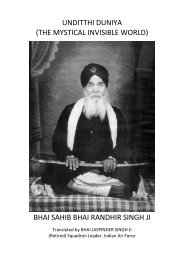Guru Gobind Singh's Death at Nanded Examination of - Vidhia.com
Guru Gobind Singh's Death at Nanded Examination of - Vidhia.com
Guru Gobind Singh's Death at Nanded Examination of - Vidhia.com
Create successful ePaper yourself
Turn your PDF publications into a flip-book with our unique Google optimized e-Paper software.
v *r<br />
38 AN EXAMINATION OF SUCCESSION THEORIES<br />
This is, however, part <strong>of</strong> the art <strong>of</strong> Braji and Panjabi<br />
poetry. Even in the second decade <strong>of</strong> the present century a<br />
Kooka poet Bhai Kala Singh Namdhari introduced imaginary<br />
supern<strong>at</strong>ural m<strong>at</strong>ter in his Singhan Namdharidn da Shahid Bilas<br />
and Singhan Namdharlan da Panth Prakash published in 1913<br />
and 1914, respectively. In these he tells us th<strong>at</strong>, in response to<br />
the prayer <strong>of</strong> the Kookas sentenced to de<strong>at</strong>h for the murders<br />
<strong>of</strong> butchers, all the <strong>Guru</strong>s and a number <strong>of</strong> Sikh martyrs like<br />
Bhai Mani Singh, Taru Singh and Sabeg Singh, appeared to<br />
them in their last moments <strong>at</strong> different times in different jails <strong>of</strong><br />
the Panjab. But they were visible only to the Kooka convicts<br />
who formally bowed to them and received their blessings.<br />
Nobody else saw them, says the poet. Yet he is rel<strong>at</strong>ing to us<br />
the story <strong>of</strong> their appearance woven in his account <strong>of</strong> the<br />
Kooka 'martyrs'. Are we to believe, as the poet like his precursors<br />
would expect us to, th<strong>at</strong> the Ten <strong>Guru</strong>s and numerous<br />
martyrs were then all alive in flesh and blood like <strong>Guru</strong><br />
<strong>Gobind</strong> Singh made by some to be living <strong>at</strong> S<strong>at</strong>ara and other<br />
places after his de<strong>at</strong>h ? There is, however, a difference in the<br />
appearance <strong>of</strong> the imaginary <strong>Guru</strong> <strong>Gobind</strong> Singh to the<br />
Mar<strong>at</strong>ha docoits imprisoned in the fort <strong>of</strong> S<strong>at</strong>ara and the<br />
appearance <strong>of</strong> the <strong>Guru</strong>s and martyrs to the Kookas in the<br />
Panjab jails. While the spirit <strong>of</strong> the <strong>Guru</strong>, according to the<br />
previous poets' stories, had rescued the dacoits from the fort<br />
and had flown them to a place <strong>of</strong> safety in the' Vindhyachal<br />
mountains over two hundred and eighty miles to the north,<br />
those who appeared to the 'Kooka martyrs' only blessed them<br />
and then left them to their f<strong>at</strong>e in the hands <strong>of</strong> the hangmen<br />
in the jails. [Shahid Bilas, pp. 50-51; Panth Prakash, 86, etc.]<br />
Giani Gian Singh, the author <strong>of</strong> the Panth Prakash<br />
(1880 A. D.) and the Tawarikh <strong>Guru</strong> Khalsa (1891-92 A.D.)<br />
in Urdu and Panjabi, however, belongs to a different class <strong>of</strong><br />
poets. History is his main objective and he has used poetry<br />
as a medium <strong>of</strong> expression as was the vogue <strong>at</strong> his time. And,<br />
for the purpose <strong>of</strong> recit<strong>at</strong>ion in large assemblies, poetry alone<br />
is the proper medium. To be an impressive poet, one must<br />
have a forceful language and a fertile imagin<strong>at</strong>ion.<br />
mourn*<br />
GURU GOBIND SINGH'S DEATH AT NANDED 39<br />
Giani Gian Singh possessed both in ample measure. As a<br />
scholar <strong>of</strong> ancient Hindu mythology, he believed in the <strong>Guru</strong><br />
having gone to heaven bodily along with his horse and accepted<br />
the legend <strong>of</strong> the <strong>Guru</strong> having been seen by four sadhus<br />
from the Panjab. To s<strong>at</strong>isfy the inquisitive and sorrowful<br />
Sikhs, Gian. Singh refers them, in the words <strong>of</strong> Bhai Daya Singh,<br />
one <strong>of</strong> the Pdnj Pyaras, to the old legend about the first<br />
<strong>Guru</strong> Nanak also having disappeared in the same supern<strong>at</strong>ural<br />
way to go to heaven. According to the poet, <strong>Guru</strong> <strong>Gobind</strong> Singh<br />
was wel<strong>com</strong>ed to heaven not only by the ancient Hindu gods<br />
but also by the previous Sikh <strong>Guru</strong>s. [Panth Prakash, second<br />
edition, Chaslma-i-Nur Press, Amritsar, 1889 A. D., pp.<br />
284-85.] Ho wever, as the author tells us, <strong>Guru</strong> <strong>Gobind</strong> Singh<br />
before his de<strong>at</strong>h formally installed the <strong>Guru</strong> Granth Sahib as<br />
the future <strong>Guru</strong> <strong>of</strong> the Sikhs. [Ibid. 282, 283, 287, AppendixXll<br />
(a).] With full faith in the de<strong>at</strong>h <strong>of</strong> the <strong>Guru</strong>, the Sikhs present<br />
<strong>at</strong> <strong>Nanded</strong>, in spite <strong>of</strong> their having heard the story <strong>of</strong> the sadhus,<br />
etc., which they did not evidently believe, performed the Bhog<br />
ceremony <strong>of</strong> the <strong>Guru</strong> Granth Sahib on the tenth day <strong>of</strong> the<br />
<strong>Guru</strong>'s de<strong>at</strong>h with all the prevalent rites. [Ibid. 287.] This has<br />
been repe<strong>at</strong>ed and confirmed by Giani Gian Singh in all the<br />
subsequent editions <strong>of</strong> his Panth Parkash, and we find it mentioned<br />
in almost the same words in its sixth edition [pp. 316-<br />
318, 321] published in October 1923.<br />
The most significant thing <strong>of</strong> the Panth Prakash (6th<br />
edition) is th<strong>at</strong> it altogether rejects the supern<strong>at</strong>ural legends<br />
and makes no mention <strong>of</strong> the <strong>Guru</strong>'s darshan by the woodcutter<br />
and sadhus or <strong>of</strong> the help rendered by the <strong>Guru</strong>'s spirit<br />
to the Mar<strong>at</strong>ha captives in the fort <strong>of</strong> S<strong>at</strong>ara, nor does it say<br />
anything about Bir<strong>at</strong> (Peshawar) or the Kotha Sahib near<br />
Kabul.<br />
With the turn <strong>of</strong> the century and dawn <strong>of</strong> scientific<br />
spirit and <strong>at</strong>titude and the development <strong>of</strong> the sense <strong>of</strong> historical<br />
objectivity, Giani Gian Singh came to realize th<strong>at</strong> his works<br />
with imaginary stories <strong>of</strong> miracles, legends, etc., associ<strong>at</strong>ed<br />
with the names <strong>of</strong> the Sikh <strong>Guru</strong>s and saints which he had<br />
blindly copied from previous writers— main marl makhi par




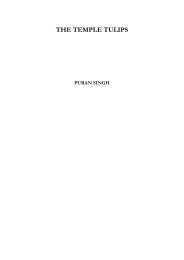
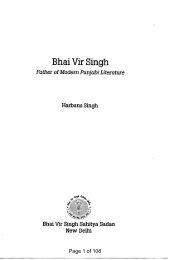

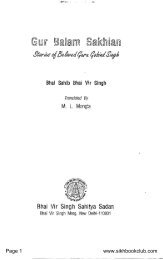
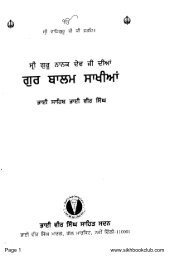
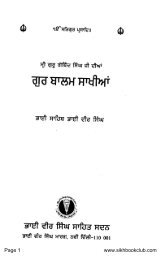
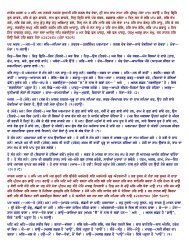
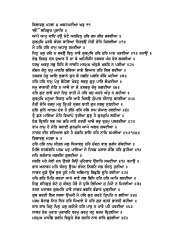

![cOpeI ] hmrI kro hwQ dY r~Cw ] pUrn hoie ic~q kI ie ... - Vidhia.com](https://img.yumpu.com/12240258/1/190x245/copei-hmri-kro-hwq-dy-rcw-purn-hoie-icq-ki-ie-vidhiacom.jpg?quality=85)
